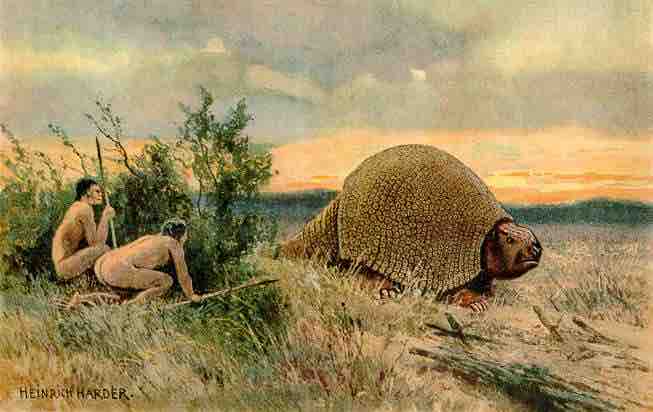Paleo-Indians, or Paleo-Americans, were the first peoples who entered and subsequently inhabited the American continent. The specifics of Paleo-Indian migration to and throughout the Americas, including the exact dates and routes traveled, are subject to ongoing research and discussion. However, the traditional theory has been that these early migrants moved into the Beringia land bridge between eastern Siberia and present-day Alaska around 40,000–17,000 years ago, when sea levels were significantly lowered due to the Quaternary glaciation. The Paleo-Indians are believed to have followed herds of now-extinct Pleistocene megafauna along ice-free corridors that stretched between the Laurentide and Cordilleran ice sheets.
Sites in Alaska (East Beringia) are where some of the earliest evidence has been found of Paleo-Indians, followed by archaeological sites in northern British Columbia, western Alberta, and the Old Crow Flats region in the Yukon. The Paleo-Indian would eventually flourish all over the Americas, creating regional variations in lifestyles. However, all of the individual groups shared a common style of stone tool production, making knapping styles and progress identifiable. This early Lithic reduction tool adaptation was utilized by highly mobile bands consisting of approximately 20 to 60 members of an extended family. In addition to hunting large animals, these families would also live on nuts, berries, fish, birds, and other aquatic mammals, but during the winter, coastal fishing groups moved inland to hunt and trap fresh food and furs.
Eventually, late Ice Age climatic changes caused plant communities and animal populations to change. Groups moved from place to place as preferred resources were depleted and new supplies were sought. Small bands utilized hunting and gathering during the spring and summer months, then broke into smaller direct family groups for the fall and winter. Family groups moved every 3–6 days, possibly covering up to 360 km (220 mi) a year. Diets were often sustaining and rich in protein due to successful hunting. Clothing was made from a variety of animal hides that were also used for shelter construction. During much of the Early and Middle Paleo-Indian periods, inland bands are thought to have subsisted primarily through hunting now-extinct megafauna. Large Pleistocene mammals were the giant beaver, steppe wisent, musk ox, mastodon, woolly mammoth, and ancient reindeer (early caribou).
Clovis Culture
Environmental changes and multiple waves of migration also led to the formation of distinct cultures. Perhaps the most significant civilization to develop in the Americas was the Clovis culture, which appeared around 11,500 BCE (13,500 BP). The Clovis peoples did not rely exclusively on megafauna for subsistence. Instead, they employed a mixed foraging strategy that included smaller terrestrial game, aquatic animals, and a variety of flora. These groups were efficient hunters and carried a variety of tools, which included highly efficient fluted style spear points, as well as microblades used for butchering and hide processing. Stone tools were traded and/or left behind from North Dakota and the Northwest Territories to Montana and Wyoming. Trade routes also have been found from the British Columbia Interior to the coast of California.
A hallmark of the toolkit associated with the Clovis culture is the distinctively shaped, fluted stone spear point, known as the Clovis point. Archaeologists do not agree on whether the widespread presence of these artifacts indicates the proliferation of a single people or the adoption of a superior technology by diverse population groups. Nevertheless, Clovis people are considered to be the ancestors of most of the indigenous cultures of the Americas.
Eventually, the Clovis culture was replaced by several more localized regional cultures from the time of the Younger Dryas cold climate period onward, about 12,000 years ago. Post-Clovis cultures include the Folsom tradition, Gainey, Suwannee-Simpson, Plainview-Goshen, Cumberland, and Redstone. Each of these is commonly thought to derive directly from Clovis and in some cases, the only difference was the in their spears and the length of the fluting on their projectile points. Although this is generally held to be the result of normal cultural change through time, numerous other reasons have been suggested to be the driving forces for the observed changes in the archaeological record, such as the Younger Dryas' impact event or post-glacial climate change with numerous faunal extinctions.
Conclusion
Eventually, the glaciers that covered the northern half of the continent began to gradually melt, exposing new land for occupation around 17,500 to 14,500 years ago. At the same time as this was occurring, worldwide extinctions among the large mammals began. In North America, camels and horses eventually died off--the latter not to reappear on the continent until the Spanish reintroduced the species near the end of the 15th century CE. As the Quaternary extinction event was happening, the early inhabitants of the Americas began to rely more on other means of subsistence. These environmental changes would not only alter hunting and migration patterns, but would also lead to the evolution of diverse civilizations in the Americas.

Paleo-Indian Hunters
The Lithic peoples, or Paleo-Indians, were nomadic hunter-gatherers and are the earliest known humans of the Americas.